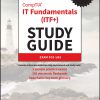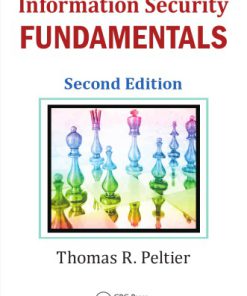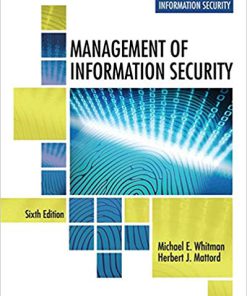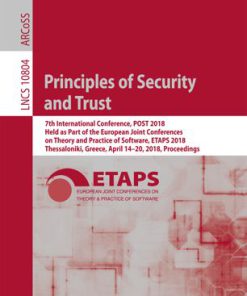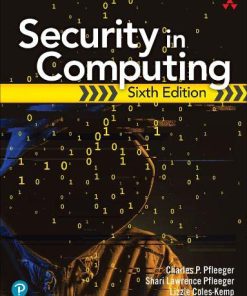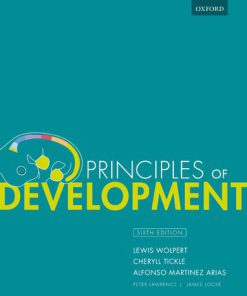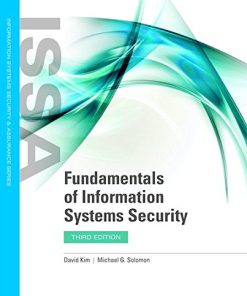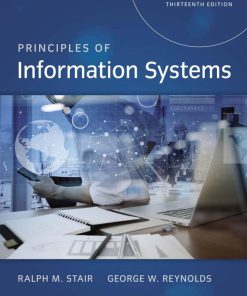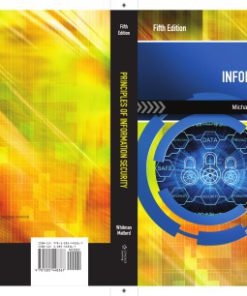Principles of Information Security 6th Edition by Michael Whitman, Herbert Mattord ISBN 9781337405713 133740571X
$50.00 Original price was: $50.00.$25.00Current price is: $25.00.
Principles of Information Security 6th Edition by Michael Whitman, Herbert Mattord – Ebook PDF Instant Download/Delivery: 9781337405713 ,133740571X
Full download Principles of Information Security 6th Edition after payment

Product details:
ISBN 10: 133740571X
ISBN 13: 9781337405713
Author: Michael Whitman, Herbert Mattord
Principles of Information Security 6th Edition Table of contents:
Chapter 1. Introduction to the Management of Information Security
Introduction to Security
CNSS Security Model
The Value of Information and the C.I.A. Triad
Key Concepts of Information Security: Threats and Attacks
The 12 Categories of Threats
Management and Leadership
Behavioral Types of Leaders
Management Characteristics
Governance
Solving Problems
Principles of Information Security Management
Planning
Policy
Programs
Protection
People
Projects
Additional Reading
Chapter Summary
Key Terms
Review Questions
Exercises
Closing Case
Chapter 2. Compliance: Law and Ethics
Introduction to Law and Ethics
Ethics in InfoSec
Ethics and Education
Deterring Unethical and Illegal Behavior
Professional Organizations and Their Codes of Conduct
Association for Computing Machinery (ACM)
International Information Systems Security Certification Consortium, Inc. (ISC)2
SANS
Information Systems Audit and Control Association (ISACA)
Information Systems Security Association (ISSA)
Information Security and Law
Types of Law
Relevant U.S. Laws
International Laws and Legal Bodies
State and Local Regulations
Standards Versus Law
Policy Versus Law
Organizational Liability and the Management of Digital Forensics
Key Law Enforcement Agencies
Managing Digital Forensics
Additional Reading
Chapter Summary
Key Terms
Review Questions
Exercises
Closing Case
Chapter 3. Governance and Strategic Planning for Security
The Role of Planning
Precursors to Planning
Strategic Planning
Creating a Strategic Plan
Planning Levels
Planning and the CISO
Information Security Governance
The ITGI Approach to Information Security Governance
NCSP Industry Framework for Information Security Governance
CERT Governing for Enterprise Security Implementation
ISO/IEC 27014:2013 Governance of Information Security
Security Convergence
Planning for Information Security Implementation
Implementing the Security Program using the SecSDLC
Additional Reading
Chapter Summary
Key Terms
Review Questions
Exercises
Closing Case
Chapter 4. Information Security Policy
Why Policy?
Policy, Standards, and Practices
Enterprise Information Security Policy
Integrating an Organization’s Mission and Objectives into the EISP
EISP Elements
Example EISP Elements
Issue-Specific Security Policy
Elements of the ISSP
Implementing the ISSP
System-Specific Security Policy
Managerial Guidance SysSPs
Technical Specification SysSPs
Guidelines for Effective Policy Development and Implementation
Developing Information Security Policy
Policy Distribution
Policy Reading
Policy Comprehension
Policy Compliance
Policy Enforcement
Policy Development and Implementation Using the SDLC
Software Support for Policy Administration
Other Approaches to Information Security Policy Development
SP 800-18, Rev. 1: Guide for Developing Security Plans for Federal Information Systems
A Final Note on Policy
Additional Reading
Chapter Summary
Key Terms
Review Questions
Exercises
Closing Case
Chapter 5. Developing the Security Program
Organizing for Security
Security in Large Organizations
Security in Medium-Sized Organizations
Security in Small Organizations
Placing Information Security Within an Organization
Components of the Security Program
Staffing the Security Function
Information Security Professional Credentials
Entering the Information Security Profession
Implementing Security Education, Training, and Awareness (SETA) Programs
Security Education
Security Training
Security Awareness
Project Management in Information Security
Projects Versus Processes
Organizational Support for Project Management
PMBOK Knowledge Areas
Project Management Tools
Additional Reading
Chapter Summary
Key Terms
Review Questions
Exercises
Closing Case
Chapter 6. Risk Management: Assessing Risk
Introduction to the Management of Risk in Information Security
Knowing Yourself and Knowing the Enemy
The Information Security Risk Management Framework
Roles of Communities of Interest in Managing Risk
Executive Governance and Support
Framework Design
Framework Implementation
Framework Monitoring and Review
Continuous Improvement
The Risk Management Process
RM Process Preparation—Establishing the Context
Risk Assessment: Risk Identification
Risk Assessment: Risk Analysis
Risk Evaluation
Risk Treatment/Risk Control
Process Communications, Monitoring, and Review
Additional Reading
Chapter Summary
Key Terms
Review Questions
Exercises
Closing Case
Chapter 7. Risk Management: Treating Risk
Introduction to Risk Treatment
Risk Treatment Strategies
Managing Risk
Feasibility and Cost-benefit Analysis
Other Methods of Establishing Feasibility
Alternatives to Feasibility Analysis
Recommended Alternative Risk Treatment Practices
Alternative Risk Management Methodologies
The OCTAVE Methods
Microsoft Risk Management Approach
FAIR
ISO Standards for InfoSec Risk Management
NIST Risk Management Framework (RMF)
Other Methods
Selecting the Best Risk Management Model
Additional Reading
Chapter Summary
Key Terms
Review Questions
Exercises
Closing Case
Chapter 8. Security Management Models
Introduction to Blueprints, Frameworks, and Security Models
Security Management Models
The ISO 27000 Series
NIST Security Publications
Control Objectives for Information and Related Technology
Committee of Sponsoring Organizations
Information Technology Infrastructure Library
Information Security Governance Framework
Security Architecture Models
TCSEC and the Trusted Computing Base
Information Technology System Evaluation Criteria
The Common Criteria
Access Control Models
Categories of Access Controls
Other Forms of Access Control
Academic Access Control Models
Bell-LaPadula Confidentiality Model
Biba Integrity Model
Clark-Wilson Integrity Model
Graham-Denning Access Control Model
Harrison-Ruzzo-Ullman Model
Brewer-Nash Model (Chinese Wall)
Additional Reading
Chapter Summary
Key Terms
Review Questions
Exercises
Closing Case
Chapter 9. Security Management Practices
Introduction to Security Practices
Security Employment Practices
Hiring
Contracts and Employment
Security Expectations in the Performance Evaluation
Termination Issues
Personnel Security Practices
Security of Personnel and Personal Data
Security Considerations for Temporary Employees, Consultants, and Other Workers
Information Security Performance Measurement
InfoSec Performance Management
Building the Performance Measurement Program
Specifying InfoSec Measurements
Collecting InfoSec Measurements
Implementing InfoSec Performance Measurement
Reporting InfoSec Performance Measurements
Benchmarking
Standards of Due Care/Due Diligence
Recommended Security Practices
Selecting Recommended Practices
Limitations to Benchmarking and Recommended Practices
Baselining
Support for Benchmarks and Baselines
ISO Certification
Additional Reading
Chapter Summary
Key Terms
Review Questions
Exercises
Closing Case
Chapter 10. Planning for Contingencies
Introduction to Contingency Planning
Fundamentals of Contingency Planning
Components of Contingency Planning
Business Impact Analysis
Contingency Planning Policies
Incident Response
Getting Started
Incident Response Policy
Incident Response Planning
Detecting Incidents
Reacting to Incidents
Recovering from Incidents
Disaster Recovery
The Disaster Recovery Process
Disaster Recovery Policy
Disaster Classification
Planning to Recover
Responding to the Disaster
Simple Disaster Recovery Plan
Business Continuity
Business Continuity Policy
Continuity Strategies
Timing and Sequence of CP Elements
Crisis Management
Business Resumption
Testing Contingency Plans
Final Thoughts on CP
Additional Reading
Chapter Summary
Key Terms
Review Questions
Exercises
Closing Case
Chapter 11. Security Maintenance
Introduction to Security Maintenance
Security Management Maintenance Models
NIST SP 800-100, Information Security Handbook: A Guide for Managers
The Security Maintenance Model
Additional Reading
Chapter Summary
Key Terms
Review Questions
Exercises
Closing Case
Chapter 12. Protection Mechanisms
Introduction to Protection Mechanisms
Access Controls and Biometrics
Managing Network Security
Firewalls
Intrusion Detection and Prevention Systems
Wireless Networking Protection
Scanning and Analysis Tools
Managing Server-Based Systems with Logging
Managing Security for Emerging Technologies
Cryptography
Encryption Operations
Using Cryptographic Controls
Managing Cryptographic Controls
Additional Reading
Chapter Summary
Key Terms
Review Questions
Exercises
Closing Case
Appendix
People also search for Principles of Information Security 6th Edition:
basic principles of information security
fundamental principles of information security
state the three key principles of information security
state the three key principles of information security
Tags:
Michael Whitman,Herbert Mattord,Information Security
You may also like…
Business & Economics - Mathematical Economics
Computers - Computer Certification & Training
Management of Information Security 6th Edition Michael E. Whitman
Computers - Programming
Computers - Security
Biology and other natural sciences - Biology
Computers - Networking
Fundamentals of information systems security 3rd Edition Kim
Computers - Computer Business & Culture
Computers - Security
Principles of Computer Security: CompTIA Security+ and Beyond Conklin
Business & Economics - Management & Leadership


